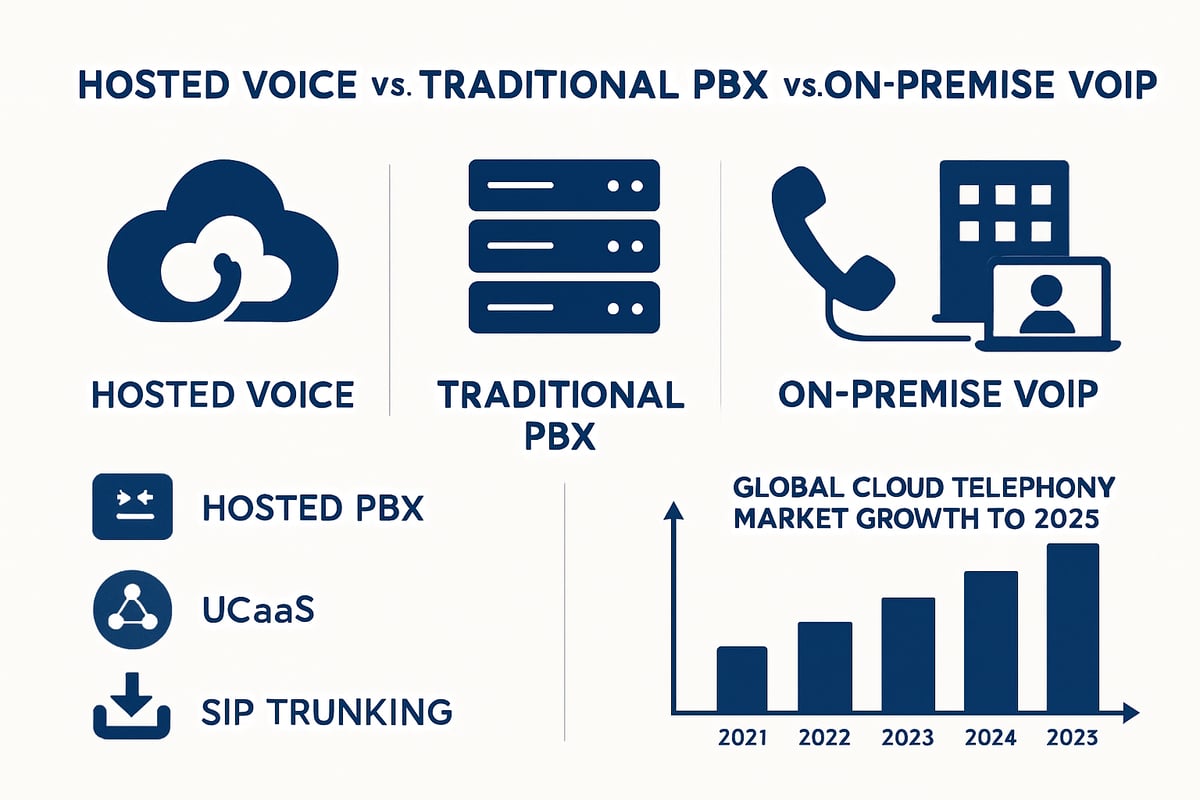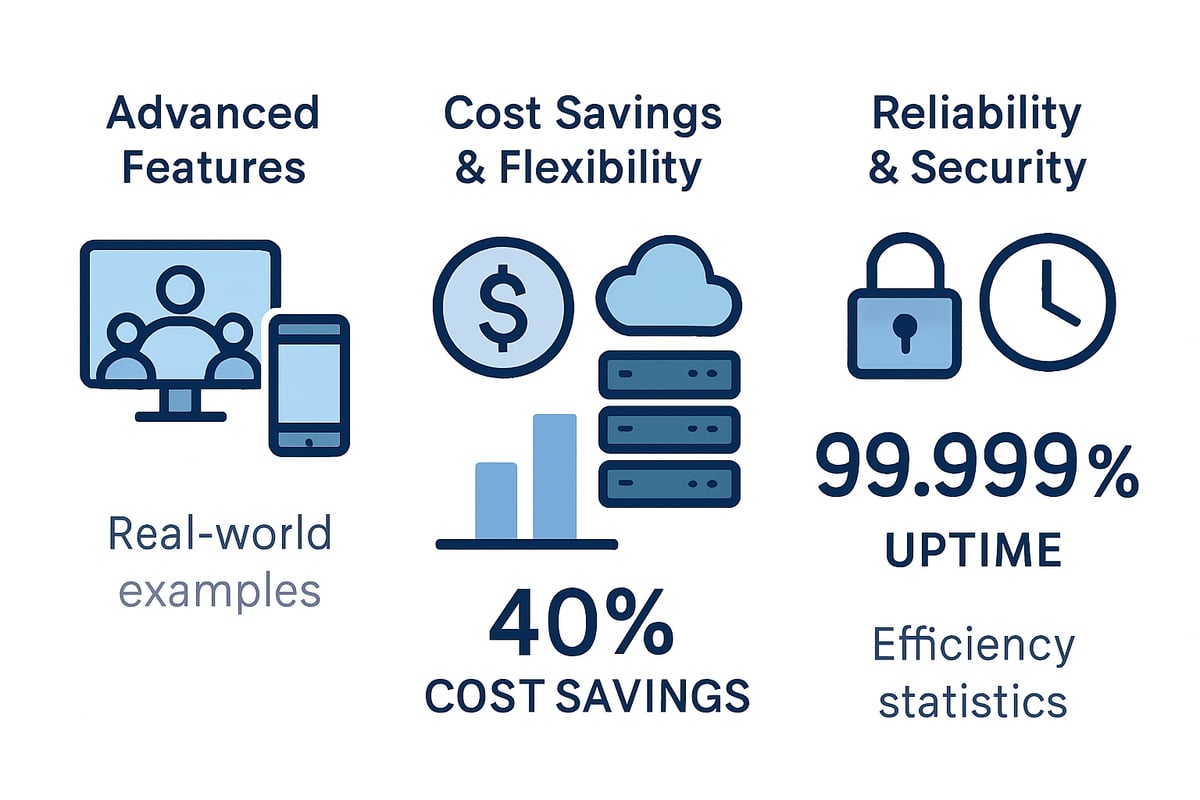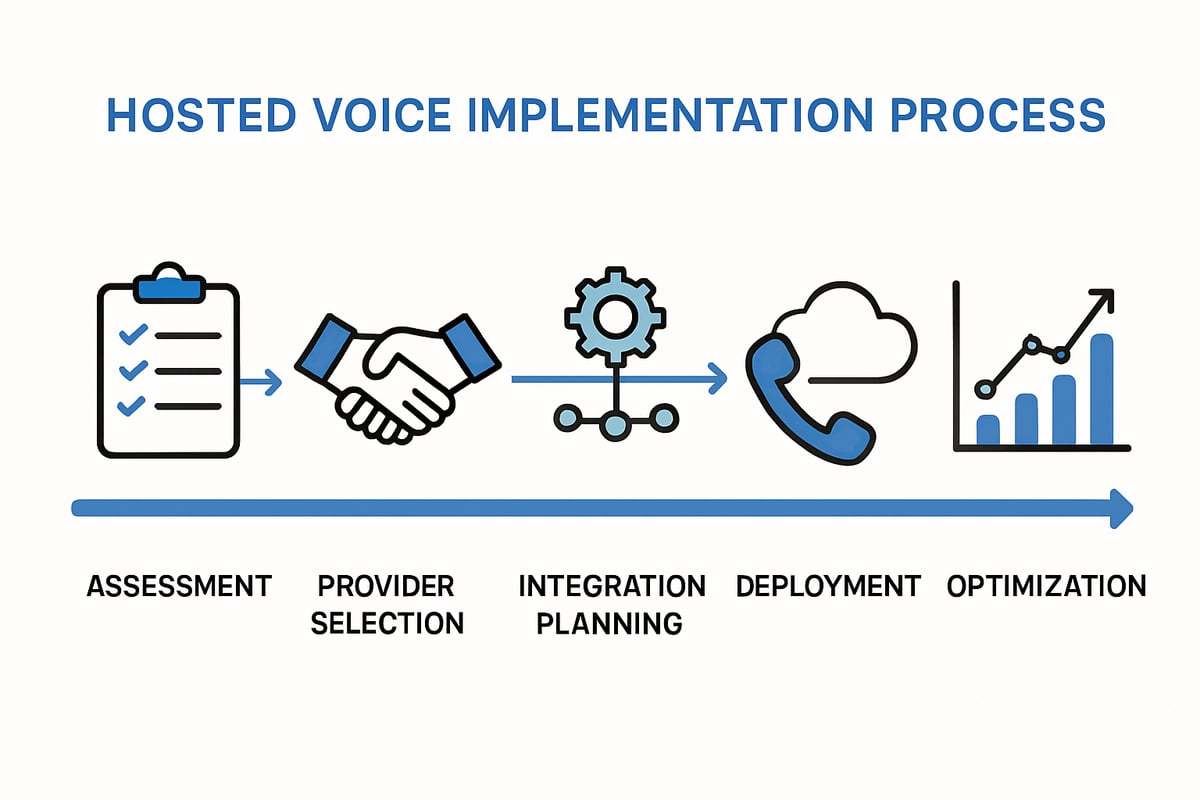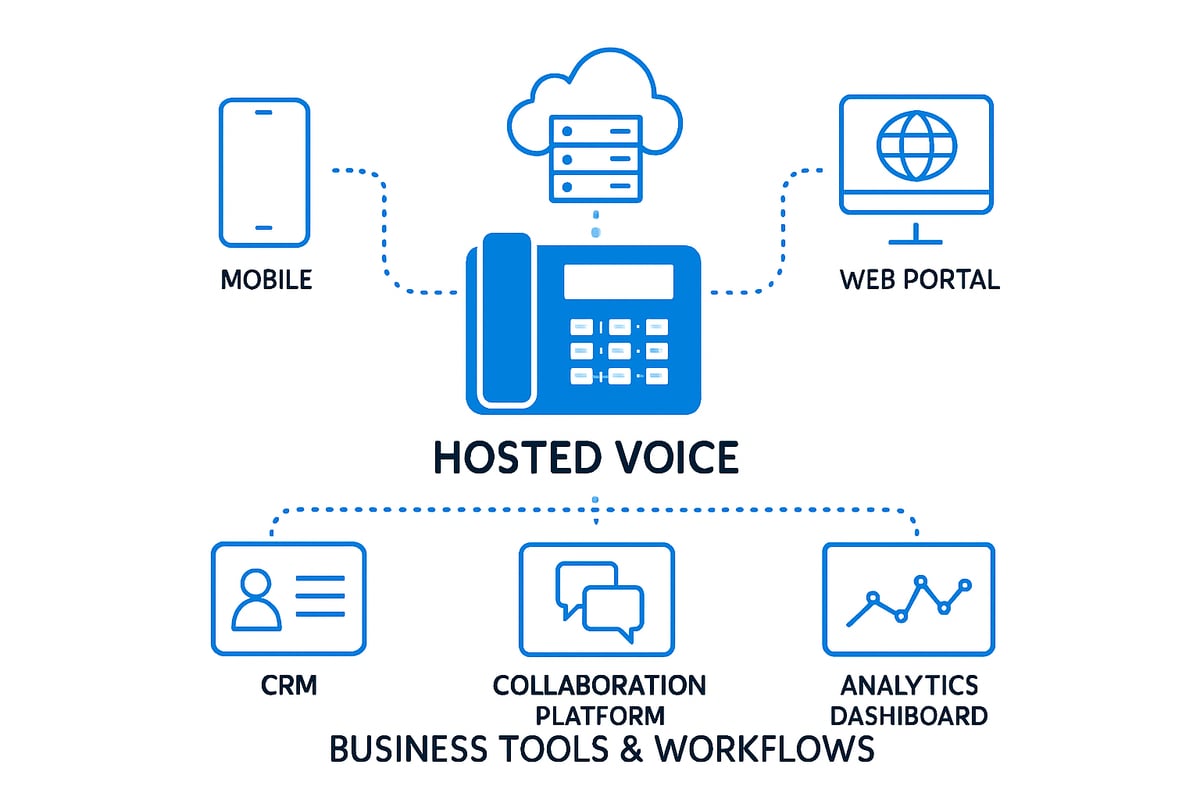Hosted Voice Guide 2025: Everything You Need to Know
Discover everything you need to know about hosted voice in 2025 including benefits, features, integration, security, and trends to empower your business.
Redaction
28/09/2025, 12:30:00Is your business prepared for the next level of communication? Hosted voice is rapidly changing the way organizations connect, collaborate, and thrive in 2025.
Traditional phone systems are being replaced by cloud-based solutions, driven by the demands of remote work, the need for cost savings, and the desire for advanced features.
Hosted voice gives your business greater flexibility, scalability, and reliability. These capabilities are essential for any modern organization aiming to stay competitive.
This guide will provide a complete overview of hosted voice in 2025. You will discover core definitions, benefits, key features, steps for implementation, how to choose a provider, integration strategies, security essentials, and future trends.
What is Hosted Voice? Core Concepts Explained
Hosted voice is a modern cloud-based phone system that shifts your business communications away from traditional, hardware-heavy PBX setups. Unlike legacy phone systems, hosted voice lets you make and manage calls over the internet, removing the need for on-premise servers or complex wiring.
At its core, hosted voice leverages Voice over Internet Protocol (VoIP) technology. VoIP converts voice into digital signals, transmitting calls securely via cloud servers managed by a third-party provider. This approach brings flexibility and reduces IT burdens, letting your team connect from anywhere with a stable internet connection.
How does hosted voice work? Instead of routing calls through physical phone lines, every call travels through the cloud. The provider handles call management, routing, and infrastructure maintenance. Your team can use IP desk phones, softphone apps on computers, or even mobile devices - all centrally managed through a web portal.
Here’s a quick comparison of communication systems:
| Feature | Hosted Voice | Traditional PBX | On-Premise VoIP |
|---|---|---|---|
| Infrastructure | Cloud-based | Onsite hardware | Onsite servers |
| Scalability | Easy, instant | Hardware-limited | Somewhat flexible |
| Maintenance | Handled by provider | IT staff required | IT staff required |
| Remote Access | Yes | Limited | Partial |
| Upfront Cost | Low | High | Moderate |
Key components of hosted voice include:
- IP phones for desk-based calling
- Softphones for computers and mobile devices
- Web portals for administration and analytics
- Cloud servers for call routing and storage
You’ll also encounter terms such as:
- Hosted PBX: A virtual phone system managed offsite
- Cloud VoIP: Voice services delivered via the cloud
- Unified Communications (UCaaS): Integration of voice, chat, video, and collaboration tools
- SIP trunking: A method for delivering voice services and unified communications via the internet
Hosted voice is especially valuable for remote, hybrid, and multi-site organizations. For example, a consulting firm can seamlessly connect remote employees using a single business number, or a retail chain can unify communications across all locations with minimal IT overhead.
Adoption is accelerating rapidly. According to VoIP adoption statistics 2025, the global cloud telephony market is projected to surpass 50 billion dollars by 2025, reflecting a widespread shift from traditional systems. Businesses are drawn to hosted voice for its flexibility, cost efficiency, and future-proof features.
As organizations prioritize agility and seamless collaboration, hosted voice is quickly becoming the gold standard for business communications. Its ability to support growth, enable mobility, and simplify IT management makes it essential for staying competitive in the evolving digital landscape.

Key Features and Benefits of Hosted Voice in 2025
Businesses in 2025 require communication systems that are both powerful and adaptable. Hosted voice stands out by delivering a suite of advanced features, cost efficiencies, and enterprise-grade reliability. Let us explore how these capabilities empower organizations to thrive in a digital-first era. For a deep dive into these capabilities, visit the hosted voice solutions overview.

Advanced Communication Features
Hosted voice equips businesses with a comprehensive set of tools to optimize communication. Key features include:
- Audio and video conferencing for seamless collaboration
- Call forwarding, advanced call routing, and voicemail-to-email
- Visual voicemail and automatic call recording for compliance and quality
- Unified Communications as a Service (UCaaS) integrations: chat, presence, and file sharing
- Mobile administration and one-number calling to support remote and hybrid teams
- Auto attendant, hunt groups, and receptionist consoles for professional call management
For instance, Fusion Connect offers over 50 hosted voice features, including Find Me/Follow Me, advanced call forwarding, and more. These functionalities enable teams to stay connected across devices and locations.
Businesses leveraging these advanced hosted voice solutions report up to 30% gains in communication efficiency. Unified messaging, mobile access, and real-time collaboration tools allow organizations to respond faster and work smarter, regardless of where teams are located.
Scalability, Flexibility, and Cost Savings
One of the most compelling benefits of hosted voice is its scalability. Organizations can easily add or remove users through a web portal, adjusting capacity without investing in new hardware or infrastructure. Pay-as-you-go pricing means you only pay for what you use, optimizing costs as your business grows.
There is no need for onsite PBX equipment or ongoing maintenance, as the provider handles upgrades and support. Hosted voice systems can be deployed quickly, often within days, making them ideal for businesses with evolving needs or multiple locations.
A cost comparison highlights the savings: On average, hosted voice reduces communication expenses by 40% compared to legacy phone systems.
| Solution | Upfront Cost | Ongoing Maintenance | Monthly Per User | Scalability |
|---|---|---|---|---|
| Legacy PBX | High | High | Moderate | Limited |
| Hosted Voice | Low | Minimal | Low | Instant |
Consider a law firm that switched to hosted voice and immediately realized substantial savings while gaining advanced mobile and call management features. This flexibility ensures organizations can adapt rapidly as their workforce or business model changes.
Reliability, Security, and Compliance
Hosted voice providers deliver enterprise-grade reliability, typically offering 99.999% uptime guarantees. Geo-redundant infrastructure ensures that calls are always routed, even in the event of local outages.
Security is paramount. Hosted voice solutions use encrypted protocols such as SRTP and SIPS to protect communications. Compliance features, including E911 for emergency services, ensure organizations meet legal and regulatory requirements.
Providers like Astound offer dedicated consulting and robust support, helping businesses achieve secure, compliant deployments. With hosted voice, organizations benefit from continuous monitoring, disaster recovery options, and strong service level agreements for peace of mind.
How to Implement Hosted Voice: Step-by-Step Guide
Implementing hosted voice can seem complex, but breaking it down into clear, actionable steps makes the process manageable for any organization. Below is a comprehensive guide designed to help you transition from legacy systems to a modern hosted voice solution with confidence.

Step 1: Assess Business Needs and Readiness
Start by evaluating your current communication landscape. A thorough assessment will clarify whether hosted voice is the right path for your business goals.
- Audit existing phone systems, hardware, and network readiness.
- Count users, locations, and remote work requirements.
- List must-have features such as call recording, mobile access, or integration with other platforms.
- Collect feedback from IT, operations, and end-users to understand pain points.
For example, a manufacturing firm might prioritize mobile administration and secure call recording to support on-the-go supervisors. This initial assessment ensures your hosted voice transition aligns with both user needs and business objectives.
Step 2: Choose the Right Hosted Voice Provider
Selecting the right provider is critical for a successful hosted voice deployment. Compare options based on reliability, features, and customer support.
- Review provider experience and reputation in your industry.
- Evaluate feature sets, security standards, and pricing models.
- Ask for demos, trial periods, and references from similar clients.
- Confirm responsiveness of support and availability of industry-specific solutions.
A law firm, for instance, may require compliance features and responsive support. Remember, 80% of businesses cite support responsiveness as a top factor when choosing a hosted voice provider.
Step 3: Plan for Integration and Migration
Once a provider is chosen, careful planning will ensure a smooth switch to hosted voice. Inventory all existing phone numbers, devices, and network infrastructure.
- Plan number porting and user migration schedules to avoid downtime.
- Ensure compatibility with CRM, helpdesk, and collaboration tools.
- Create a phased rollout plan for multi-site organizations.
- Provide training materials and schedule onboarding sessions.
For technical guidance, consult hosted voice implementation resources to streamline integration and migration. A retail chain, for example, may migrate several locations in stages to minimize disruption and keep business running smoothly.
Step 4: Deploy and Configure Hosted Voice System
With planning complete, it's time to set up and configure your hosted voice system. The deployment phase focuses on ensuring optimal performance from day one.
- Install IP phones, softphones, and user accounts.
- Configure call flows, auto attendants, and routing rules.
- Set security parameters such as encryption and access controls.
- Test call quality, failover mechanisms, and remote access features.
Pilot deployments are a smart way to catch issues early. An educational institution, for example, may run a pilot group before rolling out hosted voice campus-wide, ensuring staff are comfortable and the system is functioning as intended.
Step 5: Optimize, Monitor, and Support
Ongoing optimization keeps your hosted voice system performing at its best. Use analytics to identify trends and adjust configurations as needed.
- Monitor call quality, usage, and performance dashboards.
- Gather user feedback for continuous improvement.
- Schedule regular provider reviews for updates and feature enhancements.
- Maintain compliance and disaster recovery plans.
A finance company, for example, leverages analytics to refine call routing and monitor uptime. Regular optimization ensures your hosted voice solution continues to deliver value and reliability as your business evolves.
Integrating Hosted Voice with Business Tools and Workflows
Integrating hosted voice with your business tools unlocks new levels of efficiency, flexibility, and collaboration. As organizations embrace digital transformation, seamless communication becomes essential for productivity and growth. Hosted voice bridges the gap between traditional phone systems and the modern, cloud-based workspace.

Popular Integrations and Use Cases
Hosted voice stands out by integrating effortlessly with the platforms your teams use daily. Leading solutions connect with major CRMs like Salesforce, Zoho, and Microsoft Dynamics. These integrations enable features such as click-to-call, automatic call logging, and instant screen pops, helping sales and support staff respond faster and more effectively.
Collaboration tools are also essential in today's workplace. Hosted voice systems integrate with Microsoft Teams and Cisco Webex, allowing employees to make and receive calls directly within their preferred collaboration apps. This unified approach keeps conversations organized and accessible across channels.
Contact center solutions (CCaaS) benefit from hosted voice through intelligent call routing, real-time reporting, and advanced analytics. For example, Fusion Connect integrates hosted voice with both CRMs and productivity suites, streamlining workflows for multi-site teams.
| Integration Type | Example Platforms | Key Benefits |
|---|---|---|
| CRM | Salesforce, Zoho | Click-to-call, call logging |
| Collaboration | Microsoft Teams, Webex | Unified messaging, meetings |
| Contact Center (CCaaS) | Talkdesk, Genesys | Smart routing, analytics |
A notable case study highlights a sales team that increased conversion rates after adopting CRM-integrated hosted voice. To explore more about integration features, review the VoIP and cloud communication services page for in-depth details.
Enhancing Mobility and Remote Work
The shift to remote and hybrid work models has made mobility features a top priority for businesses. Hosted voice empowers teams to work from anywhere by providing mobile apps and softphone options for laptops, smartphones, and tablets.
Key features such as Find Me/Follow Me, sequential and simultaneous ring, and remote office capabilities ensure employees never miss important calls, regardless of their location. Visual voicemail, voicemail transcription, and fax-to-email streamline communications and boost productivity for remote workers.
A consulting firm leveraged hosted voice to enable seamless remote work, equipping consultants with mobile administration tools and flexible call routing. According to recent data, 70% of businesses cite remote work support as a primary reason for adopting hosted voice. This flexibility not only keeps teams connected but also ensures business continuity in any environment.
Streamlining Administration and Analytics
Hosted voice simplifies system management through intuitive web-based portals. Administrators can easily add or remove users, configure features, and manage support requests from a single dashboard.
Real-time analytics provide valuable insights into call volumes, usage patterns, and performance metrics. Automated provisioning minimizes setup time and reduces errors, while number porting and service ordering can be handled online.
For example, administrators at a large organization use hosted voice management tools to optimize call routing and monitor service levels, ensuring peak performance and quick issue resolution.
Security, Compliance, and Reliability in Hosted Voice
As organizations rely more on hosted voice, security, compliance, and reliability have become mission-critical. Businesses need assurance that conversations stay private, legal requirements are met, and communication never stops, even during disruptions.
Robust Security Features Protect Every Call
Hosted voice providers use enterprise-grade security to protect business communications. Calls are encrypted with protocols like SRTP and SIPS, ensuring that voice data remains confidential as it travels over the internet. Secure authentication prevents unauthorized access, while network firewalls and intrusion detection help block threats before they impact your systems.
Security is not just about technology. Leading hosted voice solutions include regular vulnerability assessments, automated software updates, and proactive monitoring. This layered approach is essential for remote and hybrid workforces, where users may connect from various locations and devices.
| Security Feature | Description |
|---|---|
| SRTP/SIPS Encryption | Encrypts voice traffic in transit |
| Secure Authentication | Prevents unauthorized access |
| Network Firewalls | Blocks malicious traffic |
| 24/7 Monitoring | Detects and responds to threats immediately |
A healthcare provider, for example, can implement hosted voice with SRTP encryption to safeguard patient conversations, meeting HIPAA requirements for voice privacy.
Meeting Compliance Requirements with Confidence
Hosted voice must support strict compliance standards across industries. For businesses in healthcare, finance, or the EU, regulations like HIPAA and GDPR mandate secure storage and transmission of sensitive information. E911 compliance ensures emergency calls are routed with accurate location data, which is vital for employee safety.
Leading hosted voice providers offer built-in compliance features, such as secure call recording, audit trails, and data retention controls. These tools help organizations avoid costly penalties and maintain trust with clients and regulators.
User training is equally important. Regular education on best practices, password management, and recognizing phishing attempts ensures compliance is not just a checkbox but a daily discipline. Security audits help identify potential gaps and keep your hosted voice environment in line with evolving standards.
Unmatched Reliability and Disaster Recovery
High availability is a hallmark of hosted voice. Providers typically guarantee 99.999% uptime, supported by geo-redundant data centers and automatic failover systems. If one server location experiences issues, calls are instantly rerouted, maintaining seamless communication.
Disaster recovery plans are integrated into hosted voice offerings. This means your business can quickly recover from outages, cyberattacks, or natural disasters without losing vital connections. Service Level Agreements (SLAs) outline guaranteed response times and escalation procedures, giving you peace of mind.
A financial institution, for instance, relies on hosted voice to ensure uninterrupted service and regulatory compliance, even during unexpected events. Real-time monitoring and 24/7 support provide an added layer of confidence.
In summary, hosted voice delivers the advanced security, robust compliance, and proven reliability that modern organizations demand. When implemented properly, it becomes the backbone of resilient, future-ready business communication.
Future Trends: What’s Next for Hosted Voice in 2025 and Beyond
The future of hosted voice is being shaped by rapid advances in artificial intelligence, automation, and analytics. AI-powered voice assistants, real-time transcription, and sentiment analysis are transforming business communications. These innovations are driving smarter, more personalized interactions between companies and their customers. According to industry insights, the voice AI industry growth is accelerating, highlighting the role of AI in the evolution of hosted voice.
AI, Analytics, and Automation
Hosted voice platforms are integrating AI to deliver advanced features like virtual assistants, automated call routing, and instant transcription. These tools not only improve efficiency but also provide valuable data for decision-making. Businesses are leveraging analytics to gain insights into customer behavior and optimize communication strategies. As AI adoption increases, hosted voice becomes a central hub for intelligent business operations.
Integration, Mobility, and Unified Communications
The integration of hosted voice with UCaaS, CCaaS, and collaboration platforms is deepening. Companies are connecting voice, video, chat, and file sharing into unified workflows, making communication seamless across devices and locations. The expansion of 5G and edge computing enhances mobility and call quality for remote and hybrid teams. For more on how these integrations are shaping the industry, visit the business communication trends blog.
Security, APIs, and Workflow Customization
Security is a top priority as hosted voice evolves. Providers are introducing biometric authentication, AI-driven threat detection, and advanced encryption to protect sensitive data. Open APIs empower organizations to automate workflows, customize integrations, and connect hosted voice with business-critical applications. This flexibility ensures companies can adapt quickly to changing needs while maintaining robust security standards.
Market Growth and Predictions
The cloud telephony market is projected to grow at a 15 percent CAGR through 2028, reflecting the increasing demand for hosted voice solutions. Enterprises are adopting hosted voice as the backbone of digital business communication, leveraging AI analytics to boost customer experience and operational efficiency. As technology advances, hosted voice will remain essential for organizations aiming to stay competitive and future-ready.Now that you understand how hosted voice can transform your business - offering reliability, flexibility, and seamless global connectivity - why not take the next step toward a future-proof communication strategy? With VoIPStore’s powerful platform, you can access enterprise-grade voice solutions, real-time analytics, and rapid integration, all backed by dedicated support and coverage in over 190 countries. If you’re ready to experience the benefits firsthand and set your organization up for scalable success, there’s no better time to get started. Let’s move your communications into the future - Start now!